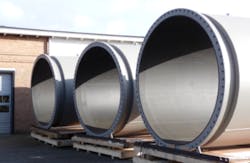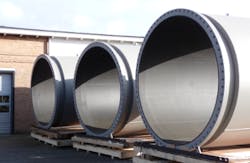Magnetic flowmeters are among the most widely used types of flowmeters for measuring the flow of water and other liquids. They have been around for more than 50 years. The Tobinmeter Company first introduced magnetic flowmeters for commercial use in Holland in 1952. Foxboro introduced them to the United States in 1954. Since this time, more than 50 suppliers worldwide have come to offer magnetic flowmeters for sale.
Magnetic flowmeters use wire coils mounted onto or outside of a pipe. A voltage is then applied to these coils, generating a magnetic field inside the pipe. As conductive liquid passes through the pipe, a voltage is generated and detected by electrodes, which are mounted on either side of the pipe. The flowmeter uses this value to compute flowrate.
One unique aspect of magnetic flowmeters is that they can only measure conductive fluids. They are excellent for water and most other liquids, but they cannot measure hydrocarbon-based fluids. This takes them out of the competition for a good part of the energy market. At the same time, they have some tremendous advantages for water and other conductive fluids.
Some advantages of magnetic flowmeters are that they can easily handle dirty liquids, slurries, wastewater, and other hard-to measure liquids. While Doppler flowmeters can also make many of these measurements, Doppler flowmeters have been on the decline due to the greater proficiency of ultrasonic transit-time flowmeters. Differential-pressure (DP) flowmeters with orifice plates can experience clogging with solids in the liquids. Magnetic flowmeters have no obstructions in the meter body to cause clogging or pressure drop.
Another unique feature of magnetic flowmeters is the number of types of liners available for different applications. These different liners make magnetic flowmeters useful for hygienic applications, for caustic liquids, and for almost any type of water application. Almost any type of conductive liquid can be measured with the right type of liner.
Magnetic flowmeters originated in Europe, and they seem to be more popular in Europe than in the United States. This could be because Europe is geographically smaller than the United States and has more liquid measurement required in a more compressed area. In addition, the top three suppliers of magnetic flowmeters are headquatered in Europe—Endress+Hauser (www.endress.com), KROHNE (www.krohne.com), and ABB (www.abb.com). In many ways, Europe is to magnetic flowmeters as differential-pressure DP flowmeters are to the United States—the flowmeter of choice with a very large installed based.
One area of research for magnetic flowmeters is reducing the level of conductivity that is the threshold for making a measurement. Just as transit-time ultrasonic suppliers have made it more possible for transit-time meters to handle liquids with more impurities, magnetic suppliers have reduced the minimum amount of conductivity required to make a reliable measurement using magmeters. While they may never be able to measure fully conductive liquids, this research is making them more versatile and able to measure more types of liquids.
Battery-operated magnetic flowmeters is another important area of research. Being able to locate magnetic flowmeters in remote locations is important for certain applications, especially in water and wastewater. Subsegments for battery-operated magmeters within water include distribution, extraction, agriculture, irrigation, and networking. Many of these remotely placed magmeters are also equipped with wireless communication. This further enhances their performance in remote areas. Likewise, wireless communication also makes it possible to use automated meter reading (AMR) for these devices when located in remote locations.
While the magnetic flowmeter market is not growing as rapidly as ultrasonic or Coriolis, it is the second largest market in terms of revenues, trailing only the DP flowmeter market. Growth in the magnetic flowmeter market is somewhat tied to population growth, since magmeters are widely used to measure flow in clean water and wastewater plants. But these meters are also displacing turbine and positive-displacement meters for some water and wastewater applications, and this will further enhance their growth.
For more information on Flow Research’s work in the area of magnetic flow measurement, visit FlowMags.com.



